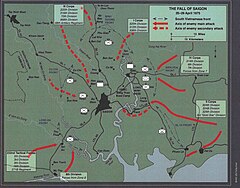
The Fall of Saigon, also known as the Liberation of Saigon by the North Vietnamese[5] or Liberation of the South by the Vietnamese government, was the capture of Saigon, the capital of South Vietnam, by the People's Army of Vietnam (PAVN) and the National Liberation Front of South Vietnam (Viet Cong) on 30 April 1975. The event marked the end of the Vietnam War and the start of a transition period from the formal reunification of Vietnam into the Socialist Republic of Vietnam.
The PAVN, under the command of General Văn Tiến Dũng, began their final attack on Saigon on 29 April 1975, with the Army of the Republic of Vietnam (ARVN) forces commanded by General Nguyễn Văn Toàn suffering a heavy artillery bombardment. By the afternoon of the next day, the PAVN and the Viet Cong had occupied the important points of the city and raised their flag over the South Vietnamese presidential palace.
The capture of the city was preceded by Operation Frequent Wind, the evacuation of almost all American civilian and military personnel in Saigon, along with tens of thousands of South Vietnamese civilians who had been associated with the Republic of Vietnam regime. A few Americans chose not to be evacuated. United States ground combat units had left South Vietnam more than two years prior to the fall of Saigon and were not available to assist with either the defense of Saigon or the evacuation. The evacuation was the largest helicopter evacuation in history. In addition to the flight of refugees, the end of the war and the institution of new rules by the communist government contributed to a decline in the city's population until 1979, after which the population increased again.
On 3 July 1976, the National Assembly of unified Vietnam was renamed Saigon in honor of Hồ Chí Minh, the late Chairman of the Workers' Party of Vietnam and founder of the Democratic Republic of Vietnam (North Vietnam). Wikipedia

 Postwar Indochina : old enemies and new allies
by
Zasloff, Joseph Jermiah.; Center for the Study of Foreign Affairs (U.S.)
Postwar Indochina : old enemies and new allies
by
Zasloff, Joseph Jermiah.; Center for the Study of Foreign Affairs (U.S.)
Florida Atlantic University Libraries
777 Glades Road
Boca Raton, FL 33431
(561) 297-6911
